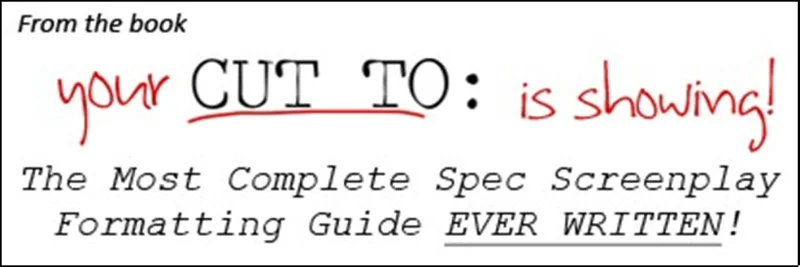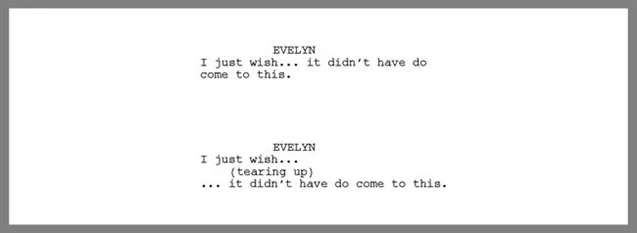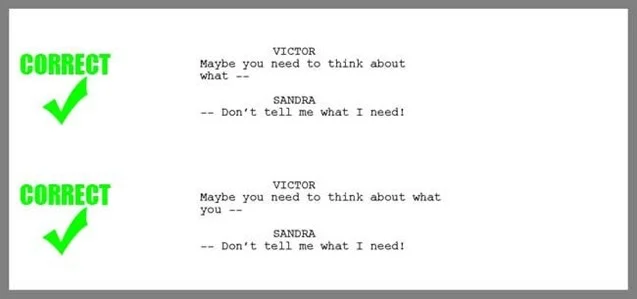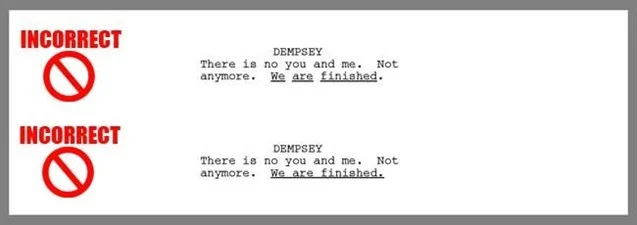
Screenwriting ABCs Script Formatting
Dialogue Punctuation Part 2
by T. J. Alex
Book Excerpt, 5 pages
Viewed by: 33 Residents and 1481 Guests

Dialogue: Punctuation Part 2
Let's continue our examination of proper punctuation usage within Dialogue.
Ellipses:
An Ellipsis is three periods, followed by a space (ellipsis... example) or three periods with a space on either side (ellipsis ... example). The former of the two ellipses examples is the way many screenwriting gurus suggest writing them within screenplays. The latter of the two is how the Chicago Manual of Style requires ellipses be written, as well as the other well-known style manuals.
Following those style manuals, this is correct:

Of course, most of those manuals also require a space BETWEEN each of the periods, a practice not necessary in screenwriting since the font used (Courier) is fixed-pitch. Bottom line: either way is fine in screenwriting.
For the rest of this lesson, we'll format Ellipses without the initial space.
Ellipses are an often used, and often MIS-used piece of Punctuation. Often Ellipses are confused with Dashes and are used interchangeably with them. Some screenwriting experts don't mind and really don't spend a lot of time differentiating between the two. Other experts draw clear lines.
When I edit a screenplay, I prefer to see Ellipses and Dashes used properly, but I don't make a big deal out of it either.
The primary use of an Ellipsis is to indicate a pause in a character's Dialogue, usually because the character is pausing to think about what he or she should say next. The Dialogue will trail off momentarily.
Here are two ways of formatting a character briefly losing her train of thought:

Sometimes when I character loses her train of thought, another character may jump in and finish the sentence for her. Here is how it might look on the page:

If a writer wants a scene to begin in the middle of a character's Dialogue, the writer may do so with an Ellipsis.
Look at this example:

Another great use of Ellipses is when writing Dialogue for a one-sided telephone conversation.
If a character is on the phone, but the audience doesn't hear the voice of the person on the other end, Ellipses are used to indicate the pauses where the character needs to allow the person on the other end of the line to speak.
Here's an example:

I included the Parenthetical (on phone). Of course, if the context of the scene makes it obvious the character is on the phone, the Parenthetical wouldn't have been necessary.
Finally, if a character says something but leaves the end of the sentence hanging (allowing the other characters and the audience to fill in the obvious blanks), then the writer will indicate the Dialogue is a complete sentence by ending it with a period, followed by an Ellipsis, thus having four periods in a row, as in this example:

Dash:
Similar to the Ellipsis is the Dash. In screenwriting a Dash is two hyphens in a row with a space on each side ( -- ).
Dashes are used most often to indicate abrupt pauses within Dialogue, or interruptions of Dialogue by other characters, off screen sounds, or action.
In the example below, there is a very brief pause in the Dialogue as the character changes his train of thought. Had the pause been longer and more, well, thoughtful, an Ellipsis would have been used in place of the Dash.

Easily the most common use of Dashes is to show Dialogue being interrupted.
Sometimes a character will be in the middle of a sentence and another character will butt in suddenly and unexpectedly, as in this example:

Other times a character's Dialogue may be interrupted by a sudden action or sound, as seen here:

When writing Dashes in Dialogue, make sure the Dash is not left alone on its own line.
In this example, Victor's Dialogue needs to be rewritten so that the Dash isn't orphaned:

Here are two ways the Dialogue could be rewritten:

In the first example, a word is forced onto the next line so the Dash is not alone. In the next example, the writer writes a little more of the sentence so there is enough Dialogue to wrap to the next line.
Underscoring:
When emphasizing a word or a line of Dialogue, writers should NEVER format the word or phrase in bold or italics. Why? Because when you ship your script to a production house, copies may be passed around to many different people, which means copies of copies of copies of copies may be made.
When this happens, often words written in bold or italics can begin to look like every other word on the page, and the writer's intended emphasis will be lost.
So, to add emphasis to words or phrases in Dialogue, a writer has two choices: writing in ALL CAPS or underscoring .
When underscoring a word or phrase, make sure it is done correctly. This may SEEM like a no-brainer. But as someone who edits and analyzes scores of screenplays, trust me, you'd be surprised.
Here are two examples of how NOT to underscore a piece of Dialogue:

In the first example, each word is underlined, but the spaces in between the words are not. Incorrect.
In the next example, the underscore extends under the ending punctuation. Also incorrect.
Here is how the underscoring should have been accomplished:

Underscoring can also be used to indicate words that should be pronounced mockingly and with emphasis, as in this example:

In this example, the DRUNK BAR PATRON throws the word friend back at the person who originally said it, ironically sending the message, "We aren't friends."
Quotations Marks:
When a character is quoting something he or she is reading, the recitation should be enclosed in Quotation Marks.

Also, when a character is repeating what another character has said, such as when one is mocking the other, the phrase should be placed in quotes, like this:

-------------------------
For more screenplay formatting rules and advice, check out the book, Your CUT TO: Is Showing! by T. J. Alex or visit www.scripttoolbox.com.
From there, please like the page on Facebook, and share it with your friends. If you have any formatting questions, please email T. J. at tj@tjalex.com.




